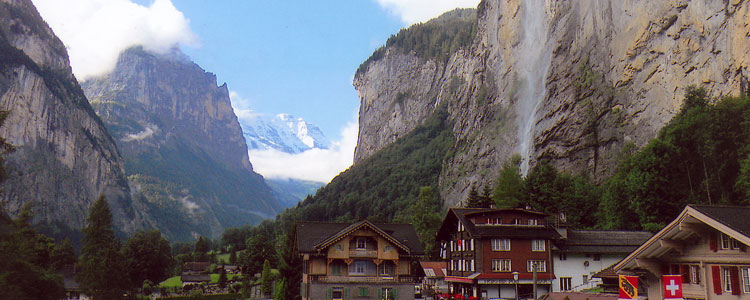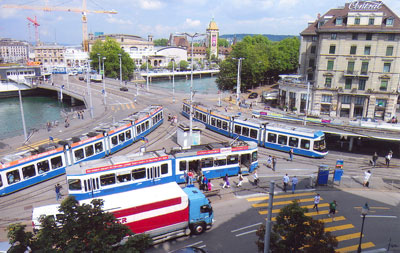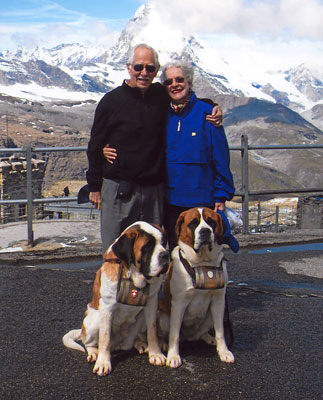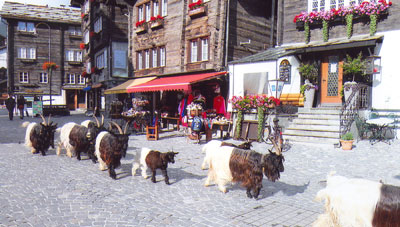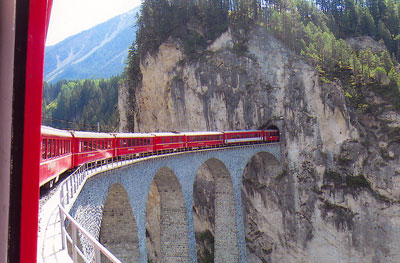Trains, trams, buses and boats — getting around Switzerland on a month’s stay
by Hugh Clark; Tampa, Florida
My wife, Ruth, and I, seniors with an average age of 87, spent the month of July ’11 traveling independently in Switzerland. We traveled using a first-class Swiss Saverpass, which, with the exception of very few private rail lines, allowed us to use the complete Swiss Travel System of trains, buses, trams and lake boats. It also gave us a 50% discount on gondolas, chairlifts and funiculars and provided free entry to some 400 museums.
Where to stay
During the 1990s we conducted train tours in Europe, primarily in Switzerland. Since then, we’ve traveled with our son, daughter-in-law and two grandchildren on eight different trips to the Alps.
To make maximum use of our Saverpass during this trip, Ruth and I left home on June 29 and took the train from Zürich’s airport to its main train station (Hauptbahnhof) when we arrived early on June 30. We traveled light, with only carry-ons.
For our first two nights we stayed in Zürich at the Limmathof Hotel (phone 011 41 44 267 60 40), located one city block from the station. Since we were hauling our own luggage, this was most convenient.
As was the case on previous trips, we settled on a mix of accommodations, choosing five hotels and two apartments. We stayed in each hotel three or four nights and one week in each apartment. In the case of the Limmathof (CHF178, or $188, per night), it was two nights at both the beginning and end of our trip.
Over the years, we have patronized different hotels in each town we visited, so the hotels we used this time were ones we selected as being our favorites for various reasons. Proximity to a train station was an important consideration in each case.
Although the Limmathof is rated only two stars, our room had all the necessary amenities, including a bathtub and TV. Breakfast started at 6 a.m., which is convenient when you have to catch an early flight, as we did at the end of our trip. The staff was most accommodating.
We have used the three-star Hotel Rössli around the corner, but we prefer the Limmathof.
Each hotel on our trip served a delicious buffet breakfast, and many offered half pension, including a main meal, usually served in the evening.
Generally, we had our main meal at a mountain restaurant. Most were excellent, and the prices were the same as in town, if not better.
Sometimes we had the option of getting something not usually on the menu at home, such as a variety of dumplings or the Austrian dessert dish called Kaiserschmarrn. We also enjoyed preparing some of our own meals in our apartments, where fondue was a special treat.
Unending options
Department stores in Switzerland often have restaurants or cafeterias located on an upper floor. The Manor in Zürich is easily the largest, most popular department store in town for locals. With that in mind, after getting settled at the Limmathof we took an easy walk to the store on Bahnhofstrasse for a delicious lunch freshly prepared for us on the fifth floor.
The next day we activated our Saverpass and had almost limitless possibilities. We could take the 50-minute train trip to Lucerne and go up Mt. Pilatus or take a lake boat from Lucerne to Kehrsiten and a funicular to Bürgenstock. Or we could opt to continue on the lake boat to Vitznau and take a mountain train up Mt. Rigi, coming down on the other side at Arth-Goldau and returning to Zürich by train.
However, with trams going in three different directions right in front of our hotel, we were seduced into staying in Zürich and riding them. For us, it was a most enjoyable, nostalgic trip back in time to the days of our youth, when most American cities of any size had such transportation.
The next day we were off on our favorite train trip in all of Switzerland: the one from Zürich to Samedan, which includes travel on the Bernina Express. We spent four nights (CHF207 per night) in Samedan at the newly renovated, rustic, three-star Hotel Donatz (phone 011 41 81 852 46 66), one block from the train station. (If you want a balcony, ask for room No. 26.)
Day-tripping
An important plus of a Swiss vacation, for us, is the opportunity to experience four different cultures with their distinctive languages — German, French, Italian and Romansch — and the interesting variations in home design, foods and customs. We traveled through the heart of the Engadine Valley, where Romansch is the prevailing language and the houses are covered with sgraffito, designs and pictures scratched into the stucco on their façades.
Our destination was Scoul, where we took a gondola (CHF12 per person) up to Motta Naluns and had lunch at a mountain restaurant with a “People to People” group of about 40 American students. After a one-hour hike there, we were ready to retrace our tracks back to Samedan.
The next day we took the slow mountain train through the Bernina Pass, reaching an elevation of 7,566 feet and continuing down to Tirano, Italy. We passed the tremendous though receding Morteratsch Glacier before hitting a series of switchbacks with great views all the way down to Italy.
Rounding out our stay in Samedan, we took a train to St. Moritz, a bus to Silvaplana and a gondola up to 8,782 feet at Corvatsch, all time coordinated, of course. Returning to St. Moritz, we went up Piz Nair via funicular and gondola for lunch and tremendous views of the surrounding area.
Leaving Samedan, we took a train to Thusis, a bus to Bellinzona and a train to Locarno, where we were booked at the three-star Hotel Garni Montaldi (phone 011 41 91 743 02 22 [website in German and Italian only]), located directly across the street from the train and bus station. From our fifth-floor balcony, we could monitor the constant flow of public transportation and enjoy the view of Lake Maggiore and the Alps in the background. Our room cost CHF194 per night.
The next day we walked half a block from our hotel and took the funicular to Orselina, continuing by gondola to Cardada. After a short hike and a chairlift ride to Cimetta, again experiencing spectacular Alpine views, we enjoyed a bountiful lunch at a mountaintop restaurant.
Bettmeralp
The rest of our month in Switzerland was filled with similarly spectacular day trips and hikes too numerous to thoroughly describe. Bettmeralp and Zermatt, with their car-free lifestyle, stand out as special to us. (Only electric vehicles are allowed.)
From the Betten train station, we took a gondola (CHF9 per person, round trip) up to Bettmeralp, located at an elevation of 6,398 feet. Our balcony apartment at Ahorn (contact Peter Heim, Weierweg 52 5722 Gränichen, CH; phone 011 41 62 842 59 32) was only a short block from the gondola station.
Our apartment (CHF529 per week) was very well furnished and could accommodate a family of four, with children’s bunk beds in a separate room.
From Bettmeralp, a gondola (CHF16 per person, round trip) took us up to Bettmerhorn (8,600 feet). After a short hike, we had spectacular views of the Aletsch Glacier; at 14 miles in length, it’s the largest in the Alps. The view was at least as good, if not better, than that from Jungfrau, which costs several times as much to reach.
As usual, we were able to enjoy a savory lunch at a mountaintop restaurant before returning to our home in Bettmeralp.
Equally spectacular from Zermatt were the mountain train trip up Gornergrat (CHF39 per person, round trip) and the gondola up to Trockener Steg (CHF32). Each gave us super views of the Matterhorn and the surrounding Alpine scenery.
Apartment rentals generally go from Saturday to Saturday, so it worked best for us to move from Bettmeralp directly to our first-floor apartment with garden patio in Kandersteg. Situated two blocks from the train station in a beautiful valley setting, Haus Interalpen (phone Cornelis Cadotsch at 011 41 33 822 16 88) cost CHF450 ($482) per week. As were the proprietors at Ahorn, Mrs. Cadotsch was most accommodating.
Zermatt
Before returning to Zürich, we wrapped up our Swiss sojourn with three nights (CHF260 per night) in Zermatt at the four-star Hotel Allalin (phone 011 41 27 966 82 66), and four nights (CHF170 per night) in Lauterbrunnen at the very comfortable two-star Hotel Staubbach (phone 011 41 33 855 54 54).
The Allalin offered impeccable service and a balcony with perfect views of the Matterhorn every day we were there.
The Staubbach offered close-up views of the 900-foot-high Staubbach Falls and the magnificent Lauterbrunnen Valley, which we enjoyed from our balcony and from the beautiful dining room. In this American-operated hotel, our newly renovated room had no television, which was an interesting experience for us. It was a pleasant journey back in time to our younger days.
Practicalities
Wherever you are in the Swiss Alps, you’ll have access to several well-marked hiking trails. Two of our favorites are the trail from Grütschalp to Mürren and the one from Männlichen to Kleine Scheidegg. Our Swiss Pass covered the gondola from Lauterbrunnen to Grütschalp and the return gondolas from Mürren down to Mittenwald and Stechelberg.
We got a 50% discount on the gondola from Wengen to Männlichen and on the mountain train from Kleine Scheidegg back to Wengen. Always ask about discounts with the Swiss Pass!
To get all the information you will need to make an intelligent decision concerning whether or not to purchase a Swiss Pass or a Eurail Pass, visit www.ricksteves.com/rail/switzerland.cfm or www.eurail.com.
Depending on how much you plan to travel, it may be less expensive, instead, to purchase public transportation tickets along the way. However, even if the Swiss Pass costs more (CHF803, or $847, per person for a one-month first-class Saverpass, valid for two or more people traveling together, according to the Swiss Travel System), the convenience of it might be worth the additional cost.
Swiss Pass is also honored on trains going through Italy, from Locarno to Brig. When it rains in central or northern Switzerland, you can often find sunny weather simply by taking a train to Locarno or Lugano in the south. The country is small enough that you can enjoy lunch and some leisure time there before returning to your base hotel.
In the past, we have traveled in Switzerland with no hotel reservations and never had a problem getting a room. This allowed us greater flexibility, as we could look at our options before deciding on a hotel. It also allowed us to negotiate the cost. It should be noted that the hotels often charge more if you stay less than three nights.
Every time we moved or went on a day trip, I would get a trip plan from the station agent. This showed our options, both going and returning, concerning departure time; track and train numbers; transfers to trains, buses or lake boats, and arrival time at our destination.
This is a wonderful service, and there is no charge for it. We found there was, generally, no waiting time for the service, except, possibly, in Zürich.
It is worth noting that arrangements can be made through Swiss Travel System to have your luggage sent directly to your hotel anywhere in Switzerland, then forwarded to your next hotel when you move. However, at a cost of CHF20 per bag per transfer, you might consider carrying your own luggage, as we did.
Trains go in every direction every hour, in fact, often more frequently. There is train service connecting the main station in Zürich and the airport every seven or eight minutes, from 5:30 a.m. to midnight, costing CHF6 in second class or CHF10 in first class for the 12-minute trip.
Many of the trains are double-deckers and are designed for travelers’ convenience. We could easily roll on and off with our luggage.
The Swiss transportation system is well coordinated, so we usually had five to eight minutes to catch a connecting train, bus or lake boat. Some trains split into two at a certain station, each section going to a separate destination. For example, when going to Lauterbrunnen from Interlaken, it is important that you read the label on the side of each car, as this train splits in Zweilütschinen, the front cars going to Lauterbrunnen and the last ones going to Grindelwald. Ask the conductor, if in doubt.
We found that an important part of our Swiss vacation was the fun of planning it, ourselves. If you are taking children and/or grandchildren, it is good to involve them in the planning process as well.
For us, as Americans used to traveling by car, Switzerland was a veritable fairyland. We felt like we were traveling on a magic carpet when experiencing the Swiss Travel System. Since we live in Florida, we always appreciate the Alps in the summer and are most fortunate that we have the opportunity to enjoy them. We highly recommend visiting.

